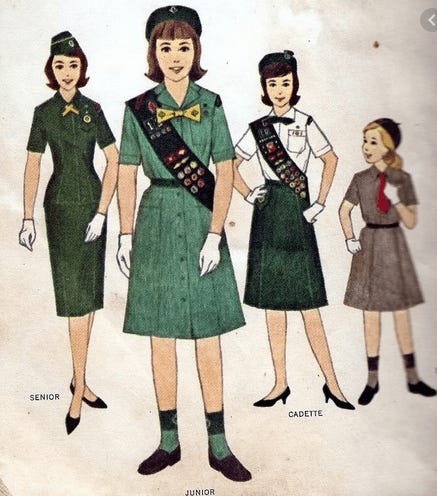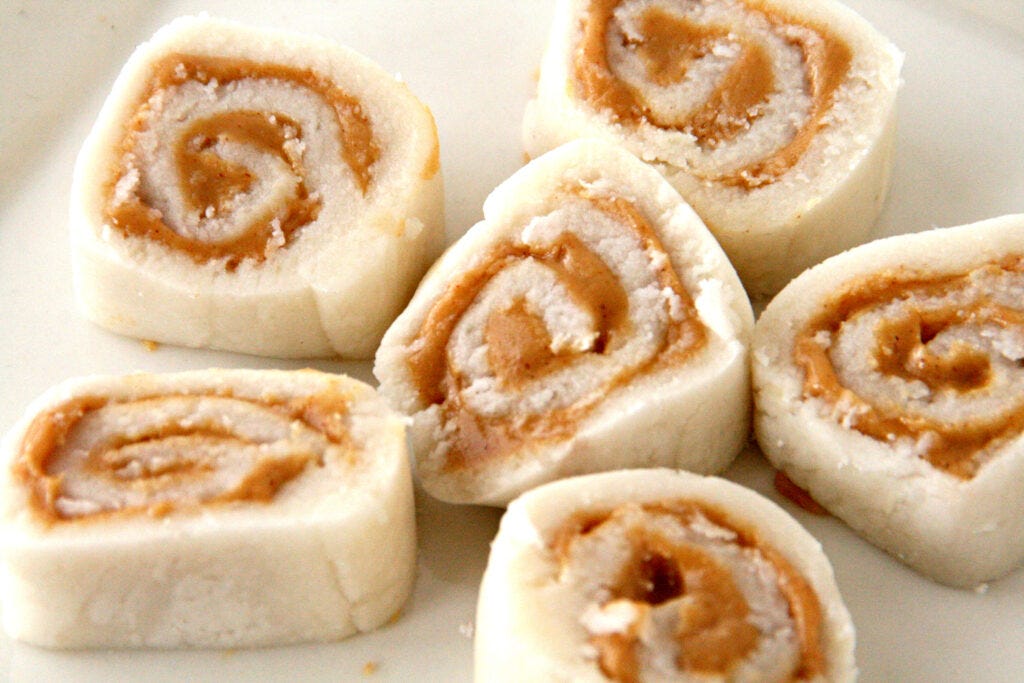People have asked how I first got interested in art, and it’s possible I could date the fascination to the time I won a contest on the Sandy Becker Show for my drawing of Snow White, which he held up to the camera for all to see. The prize was a Tiny Tears doll, and as readers may remember, I already had one of these. So my mother packed up the doll and sent it to my cousin Cathy for Christmas, without thinking that I might have a greedy desire for two Tiny Tears dolls. Do I blame this episode for my attempts to become an artist on and off over the years, ending the impulse for good in 2019 when I made the astute decision that Taos, NM, does not need one more mediocre painter.
More likely the ongoing interest in the art of others far better than I am began in Allentown, when my mother subscribed to the Metropolitan Seminars in Art (I see these were published in 1958-59, a year or two before we arrived in Pennsylvania, but for whatever reason I remember studying the volumes in the Allentown house, specifically the cherry-paneled den.) Each volume, edited by art critic John Canaday, came with a folio of prints tucked inside the front cover. I scarcely remember the subject of the “seminars,” but the prints are emblazoned in memory: van Gogh’s Starry Night, Matisse’s Lady in Blue, Raoul Dufy’s Yellow Violin, Degas’ Woman with Chrysanthemums, a Winslow Homer watercolor of a Black man in a sailboat.
I don’t know how it is that a child of 12 or so should recognize these images as superior to, say, illustrations in magazines or the art on the walls of my parents’ house, which included a couple of tenebrous and musty still lifes by my Great Aunt Ella. Could a kid have an “eye” at that age in the same way some people have perfect pitch? Or is this a faculty for discrimination that develops with time and exposure to great art? It’s a mystery that continues to engage me, and I’ve drawn other art writers into the fray—most recently in “The Educated Eye,” parts one and two, on Vasari21.
But I am getting ahead of myself….there are some questions of taste that don’t require an eye at all, like mashed-potato candy.
My mother might have been miserable in Allentown, but I was in prepubescent nirvana: a tomboy who climbed apple trees, won hopscotch championships, and skated like the wind on the pond next to the elementary school. Never again would I be this effortlessly, unselfconsciously athletic. My best friend was Bronwyn Bence, a sturdy ruddy-cheeked girl, descended from Welsh coal miners in the western part of the state.. Her mother, Emmy, was a nurse; her father had lost half an arm to a machine at the meat-packing plant and seemed to spend most of his time in a La-Z-Boy lounger, watching television and waving his angry stump at us. Sometimes, when household tensions were running high, Emmy Bence would stamp her foot and announce, “I’ve had it, Hank, I’m heading for the tall timbers. A body just can’t take anymore.”

I think I had a little crush on Bronwyn, who turned a golden tan in summer and had real breasts, definitely a B-cup, requiring a serious bra well before the rest of us. But I had a crush, too, on Mr. Sprock, our lanky sixth-grade teacher who like everyone else in those days wore a coat and tie to work. And then there was Billy van Gilder, with whom I played spin the bottle behind the forsythia bushes to the side of our yard. If I suffered any sexual confusion, it probably did not extend any further than deep blushes and an accelerated pulse. The kids I knew simply did not have a lot of interest in the mechanics of the body, though one of the neighbors’ sons got in a heap of trouble for showing the little girls how he could “make snow” with his weenie inside his family’s darkened garage.
I still had a mild interest in religion, and when Bronwyn, whose family was Methodist, asked if I wanted to go to a Bible study group one summer, I approached my mother. “No,” she said firmly. “You are going to learn to type.” Emmy Bence agreed it was a smart choice of summer “recreation,” and so for six weeks Bronwyn and I headed off to unravel the mysteries of touch typing, pressing firmly on the keys of black Corona typewriters, slinging back the carriage whenever it dinged. Those three-hour daily sessions in a hot classroom that smelled of chalk and earnest pre-teen sweat provided me with probably the most useful skill I have ever learned.
These were the years before fine distinctions about class would occur to me, but the Bence household allowed things my mother would have disdained in our home: plastic placemats, soda bottles at the dinner table, and a TV set in the living room that seemed to blare at all hours. I don’t recall our parents ever socializing, but it was Emmy Bence who carefully swaddled my father’s big toe after he ran over his foot with the lawnmower.
I know I joined them for dinner now and then, meals that included Bronwyn’s bratty younger sister, Debbie, who still sucked her thumb though she was only four years younger. For sure It was meat and potatoes, bratwurst and sauerkraut. For a special treat, we might make mashed potato candy, definitely one of the most godawful sweets ever invented, but a kid-pleasing way to take care of leftover mashed potatoes. I refuse to make this ever again, but I give you the recipe. As I remember, It keeps forever in the fridge and a roll of it can double as a doorstopper.
Mashed-Potato Candy (or Pinwheels), adapted from shockinglydelicious.com.
Ingredients:
* 1/3 cup mashed potato (from 1 potato)
* 2 tablespoons half and half (or you can use milk)
* 1 teaspoon vanilla extract
* Dash salt
* 4-6 cups confectioner’s sugar (1 1-pound box plus 2 additional cups)
* Creamy peanut butter
Instructions
1. Boil or microwave potato until it is soft. Remove and discard skin, mash (do not add anything) and cool completely. When cool, measure potato and add to a mixing bowl.
2. Add half and half, vanilla, dash of salt, and 2 cups confectioner’s sugar. Mix well using an electric mixer on low speed. Add 2 more cups confectioner’s sugar, mixing well. It should resemble dough. Add more sugar by tablespoonfuls if dough seems too wet or sticky. (I ended up using 1 pound plus ¾ cup confectioner’s sugar in mine. Your mileage may vary slightly, depending on humidity or moisture in potato.)
3. Split dough into quarters, so it is easier to work with.
4. Dust a board with confectioner’s sugar and roll out a piece of potato-sugar dough until it is roughly square or rectangular, and about ¼-inch thick. Spread one side with peanut butter. Roll up dough like a jelly roll. Repeat with others, or make flavor variations as described below.
5. Refrigerate rolls, tightly covered, for about 1 hour. Remove from refrigerator and slice roll into pinwheels.
6. Serve immediately, or return slices to refrigerator until you are ready to serve them. If you are stacking them, use a piece of waxed paper between layers so the candies won’t stick together. Cover tightly because they can dry out.
Top: Pierre Bonnard, Young Women in the Garden, 1921-22






Fortunately, I was never exposed to this seemingly horrendous mashed concoction. I remember the classic manual typewriter with its bells. Thanks for bringing back fond memories.
love memoir!!!